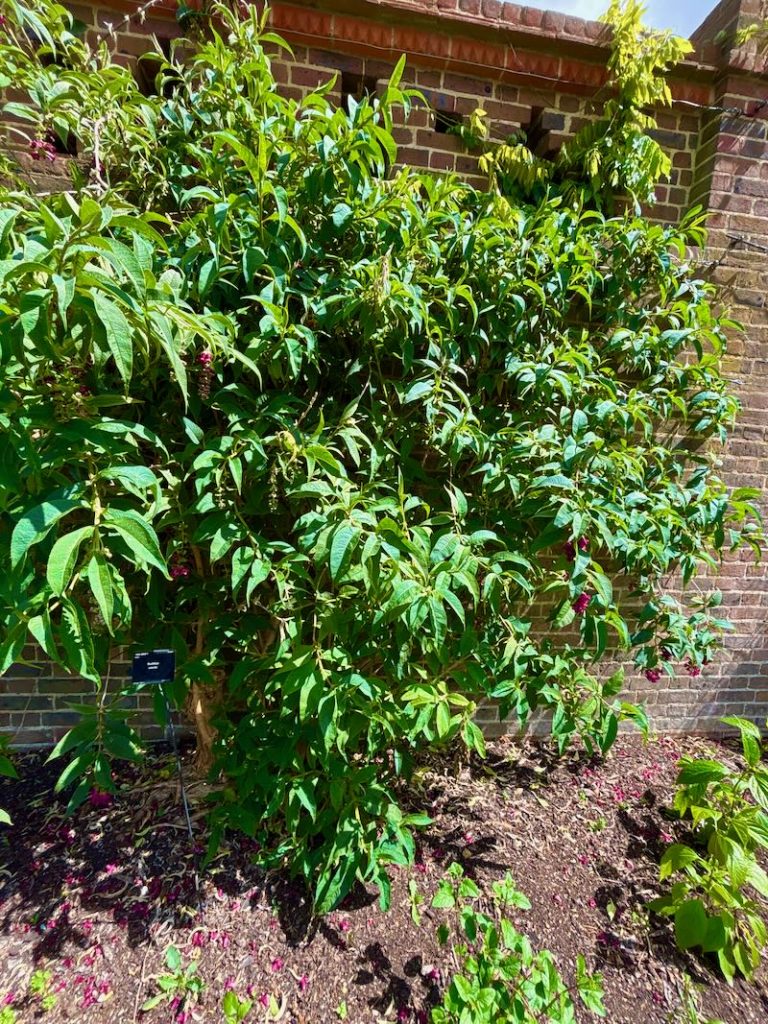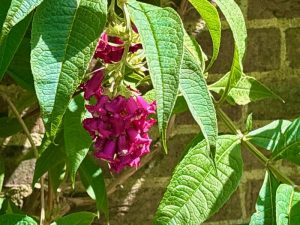Buddleja colvilei: The Handsomest Himalayan Shrub with Stunning Pendulous Flowers
Buddleja colvilei or Colvile Butterfly Bush is a striking deciduous shrub or small tree native to the eastern Himalaya. Discovered by Joseph Hooker in 1849, it was famously called “the handsomest of all Himalayan shrubs.” This species gained recognition early on when it was awarded the Royal Horticultural Society’s First Class Certificate in 1896 for outstanding exhibition excellence. Renowned for its enormous and colorful flowers, Buddleja colvilei remains a treasured ornamental shrub prized for its bold floral display and ability to attract pollinators. Buddleja colvilei belongs to the plant family Scrophulariaceae, which includes many other flowering shrubs and herbaceous plants.
Description of Buddleja colvilei
Buddleja colvilei grows as a large shrub or small tree, reaching heights of over 13 meters (42 feet), often featuring a single sturdy stem. Its flowers are among the largest within the Buddleja genus, arranged in drooping panicles measuring 15–20 cm (6–8 inches) long and more than 8 cm (3 inches) wide. These flowers vary in color from rose pink to deep crimson, frequently exhibiting a white throat inside the corolla tube. Flowering typically occurs in June, signaling the start of summer.
The leaves of B. colvilei are narrow, less than 25 cm (10 inches) long, shallowly toothed, and taper at both ends. They grow opposite each other on the stem and are covered in stellate (star-shaped) hairs when young, which often become glabrous with age. This species exhibits a remarkable degree of polyploidy, with chromosome counts ranging between 2n = 152 to 456 (8x–24x), a rare feature that contributes to its distinctiveness.
The shrub presents a bushy habit and produces branchlets that are subquadrangular to subterete with a dense tomentose (woolly) covering of stellate and glandular hairs. Its inflorescences form terminal cymes up to 25 × 10 cm (10 × 4 inches) with campanulate calyces and corollas that are cylindrical, measuring 1.5–2.5 cm (0.6–1 inch) in diameter. Stamens and pistils are prominent inside the flowers, contributing to their attractiveness to pollinators.
Natural Distribution and Habitat
Buddleja colvilei is endemic to the eastern Himalayan region, found in Bhutan, China (South Xizang and Yunnan provinces), India (Assam and Sikkim), and Nepal. It naturally inhabits open forests, thickets, and mountain clearings at altitudes between 1600 and 4200 meters (5,250–13,780 feet) above sea level. These elevations provide a cool, moist climate ideal for its growth and flowering cycle.
Although it grows across a broad range, no global conservation assessment has formally evaluated B. colvilei, but the China Biodiversity Red List classifies it as vulnerable because habitat pressures threaten it. It prefers well-drained soils in sunny locations and tolerates various soil types except waterlogged or extremely dry ones.
How to Grow Buddleja colvilei
Light Requirements
Plant Buddleja colvilei in full sun to encourage vigorous growth and abundant flowering. It requires at least 6 to 8 hours of direct sunlight daily. Partial shade may reduce flowering intensity and overall vigor.
Soil Conditions
This species tolerates a range of soil types but thrives best in fertile, well-drained soils. Avoid heavy, waterlogged soils which can lead to root rot, especially during winter. Amend clay soils with organic matter like compost or plant in raised beds to improve drainage. In sandy soils, adding peat moss or rich topsoil will help retain moisture.
Watering
After planting, water thoroughly to settle soil around the roots. Established plants are moderately drought-tolerant but benefit from weekly deep watering during hot, dry spells to maintain healthy foliage and flower production. Container-grown specimens require more frequent watering. Always avoid waterlogged soil.
Fertilizing
Apply a balanced slow-release fertilizer in early spring to support the growing season. Excess nitrogen should be avoided as it encourages leafy growth at the expense of flowers. Moderate feeding promotes vibrant blooms without overly lush foliage.
Pruning
Prune Buddleja colvilei in late winter or early spring before new growth begins. This stimulates healthy new shoots where flowers will form. Pruning also helps maintain a desired size and shape. Remove faded flower heads (deadheading) throughout the season to encourage continuous blooming.
Propagation of Buddleja colvilei
Propagate through semi-ripe stem cuttings taken in summer. Using rooting hormone enhances success rates by promoting root development. While seed propagation is possible, it is less common due to slower growth and variability.
Pests and Diseases
Buddleja colvilei is generally resistant to most pests and diseases but can occasionally be affected by aphids, capsid bugs, caterpillars, earwigs, figwort weevils, spider mites, leaf and bud eelworms, and mullein moths. Spider mites are more common during hot, dry conditions. Fungal issues such as botrytis and downy mildew can develop in cool, damp environments. To prevent disease, ensure good air circulation and avoid excessive watering.
Winter Care and Hardiness
This species is hardy in USDA zones 7 to 9 and tolerates temperatures down to approximately -10°C (14°F). It is semi-deciduous, shedding leaves in cold winters but often retaining foliage in milder climates. In colder regions, protect roots with mulch in late fall to insulate against freezing temperatures and harsh winds.
Growth Habit and Flowering Season
Over time, Buddleja colvilei grows into a substantial shrub or small tree, reaching 2 to 6 meters (6.5–20 feet) with a bushy habit. Its pendulous flower panicles, often 15–20 cm (6–8 inches) long, bloom from late spring through early summer (May to June in temperate regions). The flowers’ large size and vibrant shades of pink to crimson make this shrub immediately recognizable.
Environmental Tolerances
While moderately hardy, young plants are somewhat tender and benefit from sheltered planting sites such as against a south-facing wall. Exposure to harsh frosts can damage flower buds and reduce blooming. The plant tolerates a range of soils but avoids extremes of dryness or waterlogging.
Cultivars of Buddleja colvilei
Recognized cultivars include ‘Kewensis’ and ‘Howth Castle’, both selected for desirable flower colors and growth habits. These cultivars maintain the species’ signature large flowers and robust growth, suitable for ornamental planting in mild climates.
Summary
Buddleja colvilei is an extraordinary Himalayan shrub popular for its enormous, pendulous flowers and graceful presence. It suits gardeners seeking a bold statement shrub that attracts butterflies and other pollinators. With proper care—full sun, well-drained soil, moderate watering, and annual pruning—this species rewards gardeners with a spectacular floral display from late spring to early summer. Its adaptability to temperate climates combined with its historical botanical significance makes Buddleja colvilei a prized addition to any collection.



